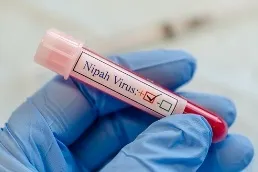What Happened to the High-Risk Contact Patient in Kerala?

Synopsis
Key Takeaways
- Nipah virus is a serious public health concern in Kerala.
- Immediate testing and monitoring are essential for high-risk contacts.
- Authorities are on high alert to contain and manage outbreaks.
- Public awareness and hygiene are critical in preventing further spread.
- Fruit bats are identified as the main carriers of the virus.
Malappuram, July 9 (NationPress) A woman receiving treatment at a government hospital nearby, recognized as a high-risk contact of a Nipah-infected patient who passed away last month, tragically succumbed on Wednesday.
The deceased was hospitalized in the same ward as the previous Nipah victim.
In light of her passing, the health department has advised her family to postpone the funeral until the final test results from the National Institute of Virology in Pune are obtained.
This news follows the critical condition of another Nipah-positive patient currently being treated at Kozhikode Medical College and Hospital.
Initially identified in Malaysia in 1999, the Nipah virus has sparked numerous deadly outbreaks in South and Southeast Asia. Kerala has been the most impacted state in India, reporting six outbreaks since 2018, resulting in 17 fatalities since the first outbreak in Perambra, Kozhikode.
A total of 482 individuals are currently on the Nipah contact list in Kerala, including 192 in Malappuram, 114 in Kozhikode, and 176 in Palakkad. Health officials across these districts are on high alert.
In Palakkad, the patient's home district is now under a containment zone that extends three kilometers from the patient's residence. Field surveillance is actively taking place, with officials gathering retrospective data from the last six months, and veterinary teams conducting inspections in the vicinity.
The Nipah virus (NiV) is a highly lethal zoonotic pathogen transmitted from animals to humans, capable of causing acute encephalitis, severe respiratory distress, and often resulting in death.
Investigations have revealed that fruit bats, commonly known as flying foxes, are the likely origin of the virus. Nipah spreads through direct contact with infected animals (such as pigs), consumption of fruits or palm sap tainted by fruit bats, and through human-to-human transmission via bodily fluids or contaminated surfaces.








